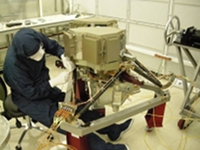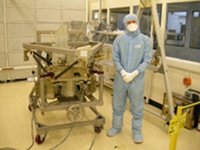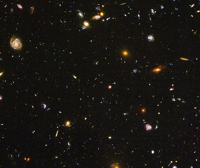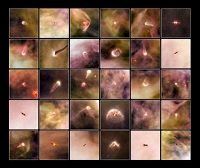MIRI starts to take shape
30 September 2010
A major instrument due to fly aboard the James Webb Space Telescope is getting its first taste of space in the test facilities at the Rutherford Appleton Laboratory (RAL) in the United Kingdom. The Mid-InfraRed Instrument (MIRI) has been designed to contribute to areas of investigation as diverse as the first light in the early Universe and the formation of planets around other stars.The James Webb Space Telescope represents the next generation of space telescope and, unlike its predecessor Hubble, it will have to journey far from home. With a prospective launch date in 2014 its ultimate destination is L2, a gravitational pivot point located 1.5 million kilometres away, on the opposite side of the Earth from the Sun. Here it is cool enough for MIRI's instruments to obtain the exquisite measurements that astronomers will use to help decipher the Universe. "At L2 we are at an environmentally stable point where we can be permanently shaded from light from the Sun and from the Earth. That allows us to reach the very low temperatures - as low as 7K in the case of MIRI – that are necessary to measure in the mid-infrared," says Jose Lorenzo Alvarez, MIRI Instrument Manager for ESA.
One of the jewels in MIRI's crown is the potential to observe star formation that has been triggered by an interaction between galaxies. Conventionally, this has been difficult to study since the optical and near-infrared emission from these newly formed stars is hidden from view, shrouded by the dust and gas of the natal cloud. This will not be a problem for MIRI, so long as its operating temperature remains at 7K, as it is sensitive to longer wavelengths of light in the range 5 to 28 microns, which can penetrate the dust.
However, keeping MIRI at a colder temperature than on Pluto, for a sustained period of time, was one of the biggest engineering challenges facing those charged with constructing the instrument. "The critical aspect, to achieve the right sensitivity, is to ensure stable operation at 7K that will last for the five years of the mission," explains Alvarez.
 |
 |
|
Integration of the MIRI flight model (left) in the cleanroom at RAL (right). Credit: MIRI European Consortium/RAL |
|
In Spring this year, the flight model of MIRI began to take shape as the key sub-assemblies - the imager, the spectrometer optics, and the input-optics and calibration module - were delivered to RAL for integration. Each of the optical sub-assemblies of MIRI had at that stage already, separately, undergone exhaustive mechanical and thermal testing to make sure they can not only survive the rigours of a journey to L2, but also remain operational for the life of the mission. At RAL, the sub-assemblies were integrated into the flight model and are now being tested again, as a complete instrument, using a specially designed chamber developed at RAL to reproduce the environment at L2. For the purposes of these environmental and calibration tests the JWST telescope optics are simulated using the MIRI Telescope Simulator (MTS) that was built in Spain. Following completion of these tests, the MIRI will be shipped to NASA's Goddard Space Flight Center in the US, next Spring, when the instrument will be integrated with the JWST Integrated Science Instrument Module.
When MIRI eventually reaches its sheltered position, located four times further away from the Earth than the Moon, scientists can begin probing the Universe's secrets, including its earliest days. "We'd like to try and identify very young galaxies, containing some of the first stars that formed in the Universe," says Gillian Wright, European Principal Investigator for MIRI based at the UK Astronomy Technology Centre.
|
Left: Hubble Ultra Deep Field. MIRI will play a key role in demonstrating which galaxies are undergoing their first episodes of star formation. Credit: NASA, ESA, and S. Beckwith (STScI) and the HUDF Team. |
|
With the current generation of space telescopes, distinguishing between a galaxy mature enough to have a central black hole and a young galaxy at a high redshift is troublesome as they appeared similar in the near-infrared. The key to MIRI's potential success is again its ability to see through cosmic dust. When stars form they burn through the elements, creating dust which ends up in the interstellar medium of the galaxy. The re-radiated emission from this dust creates a spectrum markedly different from that of a galaxy with no dust; the emission is expected to be 5-10 times stronger in the mature galaxy. "MIRI provides a diagnostic of whether there has been a previous generation of stars that had gone supernova and created dust. In the first generation of stars there would be no dust or black holes because there hadn't been time to make any," explains Wright.
The astronomers who will use MIRI and the James Webb Space Telescope are also particularly keen to explore the formation of planets around distant stars, another area where the ability to peer through the dust becomes important. "MIRI is absolutely essential for understanding planet formation because we know that it occurs in regions which are deeply embedded in dust," said Wright. MIRI's beam width of 0.1 arc seconds allows the instrument to image 30-35 Astronomical Units (AU) of a protoplanetary disc. With most such discs thought to be hundreds of AU across, MIRI can build up highly resolved mosaics of these planetary nurseries in unprecedented detail. With its spectrometer, MIRI could even reveal the existence of water and/or hydrocarbons within the debris, paving the way for investigations into the habitability of other planetary systems.
Notes for Editors
The James Webb Space Telescope is a joint project of NASA, ESA and the Canadian Space Agency. It is scheduled to launch in 2014 and will carry four scientific instruments: MIRI (a mid-infrared camera and spectrograph), NIRSpec (a near-infrared spectrograph), NIRCam (a near-infrared camera), and TFI (a tunable filter imager).
MIRI, the mid-infrared instrument, provides imaging, coronagraphy and integral field spectroscopy over the 5-28 micron wavelength range. It is being developed as a partnership between Europe and the USA - the main partners are ESA, a consortium of nationally funded European institutes, the Jet Propulsion Laboratory (JPL), and NASA's Goddard Space Flight Center (GSFC). The European consortium comprises: Astronomy Technology Centre, UK; Astron, Netherlands Foundation for Research in Astronomy, Netherlands; CCLRC, Rutherford Appleton Laboratory (RAL), UK; CEA Service d'Astrophysique, Saclay, France; Centre Spatial de Liège, Belgium; Consejo Superior de Investigaciones Científicas (CSIC), Spain; Danish Space Research Institute (DSRI), Denmark; Dublin Institute for Advanced Studies, Ireland; EADS Astrium Ltd, UK; Institut d'Astrophysique Spatiale (IAS), Orsay, France; Instituto Nacional de Técnica Aeroespacial (INTA), Spain; Laboratoire d'Astrophysique de Marseille (LAM), France; Max-Planck-Institut fur Astronomie (MPIA), Germany; Observatoire de Paris, France; Paul Scherrer Institut, Switzerland; University of Amsterdam, Netherlands; University of Cologne, Germany; University of Leicester, UK; University of Leiden, Netherlands; University of Leuven, Belgium; and University of Stockholm, Sweden.
Contacts
Jose Lorenzo Alvarez
ESA MIRI Instrument Manager and Principal System Engineer
Scientific Projects Department
Directorate of Science & Robotic Exploration, European Space Agency
Email: jose.lorenzo.alvarez esa.int
esa.int
Phone: +31 (0)71 5653598
Gillian Wright
European Principal Investigator for MIRI
UK Astronomy Technology Centre
Royal Observatory, Edinburgh
United Kingdom
Email: gsw roe.ac.uk
roe.ac.uk
Phone: +44 (0)131 668 8248





